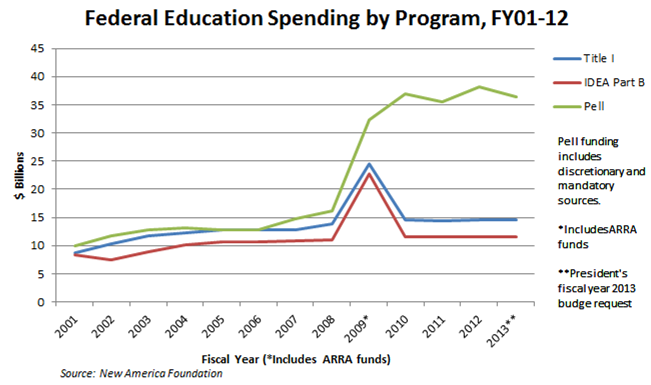How the Pell Grant Program Overtook PreK-12 Education Programs
Blog Post
Nov. 13, 2012
In 2009, President Obama and a Democratic Congress passed the American Recovery and Reinvestment Act (ARRA), an economic stimulus package that included large, one-time cash infusions for some of the federal government’s largest education programs. But since then, Congress and the president reset funding for key PreK-12 programs back to their prior funding levels and haven’t increased it since. Meanwhile, they’ve ensured that the Pell Grant program for undergraduate students from low-income families maintained the one-time funding gains and then some. Will a second-term Obama administration continue this Pell-at-the-expense-of-everything-else policy? First, let’s review how policymakers got here.
Under the stimulus bill, Title I funding for disadvantaged PreK-12 students grew by $10 billion. Special education state grants under Part B of the Individuals with Disabilities Education Act (IDEA) nearly doubled, with an extra $11.3 billion, in addition to the program’s regular 2009 appropriation of $11.5 billion. And the Pell Grant program for low-income college students got a $15.6 billion add-on to its 2009 appropriation of $17.3 billion.
Since then, lawmakers have boosted the U.S. Department of Education’s budget overall by a healthy sum (especially when compared with other agencies), up from $59.2 billion in fiscal year 2008 to $68.1 billion in 2012. Amidst that healthy increase, however, lawmakers kept Title I funding and IDEA funding essentially flat.
What explains the overall funding increase? A big part of it went to Pell Grants. But there is more to the explanation. After the stimulus money had run out for other education programs, lawmakers approved four additional years of emergency supplemental funding for Pell Grants, which coincided with a separate increase to an entitlement funding stream for the program that started in 2008. The result may be the largest funding increase for any federal education program in history—while other programs remained flat.

Here’s the kicker: That emergency supplemental funding lawmakers approved for Pell Grants will run out this year. So the program needs another infusion of funding of about $5.8 billion, according to the Congressional Budget Office, just to keep it going in its current form. The following year that figure jumps to $8.7 billion. Over the next 10 years, the total gap is $76.5 billion.
Over the coming weeks and months, it’s time for lawmakers to starting thinking about smart ways to reform the Pell Grant program and put it on a sustainable funding path—but also to ensure that the program serves low-income college students well. PreK-12 programs have a lot riding on that outcome.